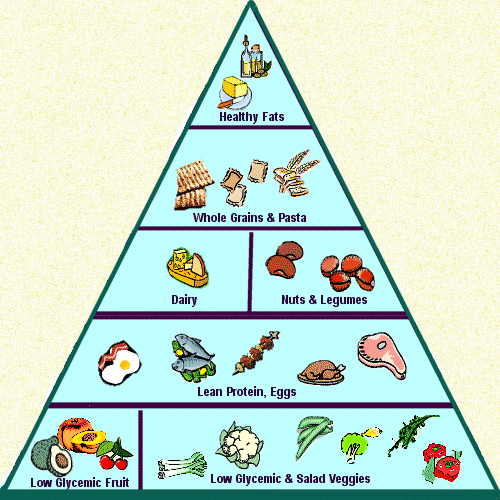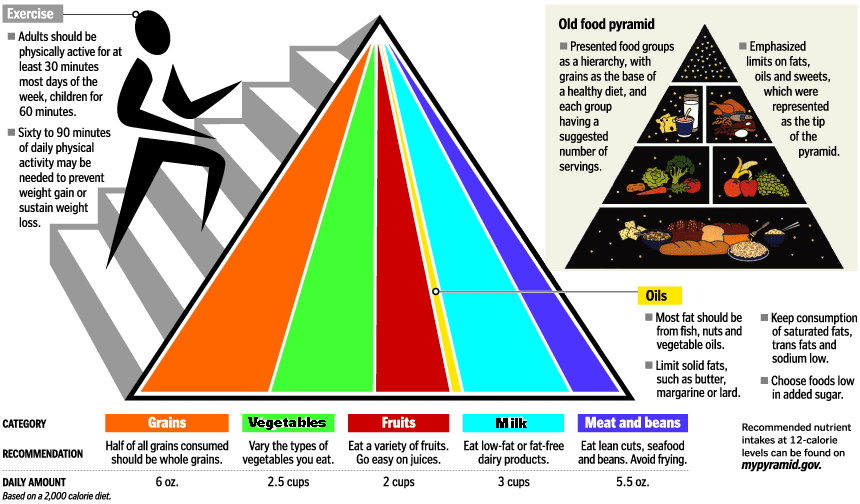FDA Food Pyramid Defects: Facts, Fallacies and Fat-Phobia
LITANY
Back in 1894 the USFDA published its first dietary recommendations to help American kids learn what to eat and how much of it. Nutritionist Caroline Hunt was signed on for the task; she came up with 5 food groups: milk and meat, cereals, vegetables and fruits, fats and fatty foods and sugary foods.
That seemed to suffice for several decades until FDR (President Franklin D. Roosevelt) sounded the trumpet at the 1941 National Nutrition Conference prompting the first use of the RDA (Recommended Dietary Allowance) seen on all food labels since. (RDA means the minimum nutrition to sustain life while in an inactive, nearly vegetative state - read, useless).
In 1943 we were hot for the Basic Seven (modified for WWII wartime food rationing). When Baby Boomers were in diapers through high school, it was the Basic Four until 1970 when the USFDA stepped in to address the advent of unhealthy foods by adding a fifth category. Fairly aquiver about the ills of all fats, sweets and alcohol, they thought they really had it nailed.
The first pyramid food graphic hit the media in 1992 replete with pictorial clues and shaping intent on conveying the concepts of variety, proportion and moderation with horizontal slabs across a triangle.
But none of them worked ... none of 'em.
Survey said, 40% of consumers were just as confused as ever about what to eat. We kept on eating whatever we wanted and whatever felt good. Our wild eating most assuredly stemmed then, as it does now, from the clever prodding and teasing of media advertising, mostly television; it's attenuating huge profit margins are highly implicit.
The best byproduct of the food pyramid awareness saga were the required nutritional food labels to appear on all packaged foods, enacted by Congress in 1994 - finally, some objective and helpful information.
2005 brought about a perhaps guilt-ridden click-and-tap website (www.MyPyramid.gov) from the USFDA. Plug in your stats and calories eaten to see how you're doing; it's NOT the end-all and be-all resource for pure nutrition sanity, but helpful all the same.
Now here we are with the 2006 USFDA Food Pyramid, a guy climbing up the side indicating the need for exercise. Duh. We're stuck with the pyramid shape I guess, despite the altogether meaningless of the vertical-wedges-in-a-pyramid. (I was not consulted in this matter.)
A PLETHORA OF PYRAMIDS
Meanwhile, food and diet entrepreneurs devised their own pyramids hoping to capitalize on the confusion; some of them did and rather successfully... .
Whereas the USFDA Food Pyramid shamelessly pimps dairy and grains, puppeted by the heavy-thumbed wheat and dairy industries and umbilicled Washington lobbies), the slightly better Mediterranean Diet Pyramid goes heavy on the bread and pasta, per piacere. That's fine, if you're a sweat and no-collar laborer, not fine if you push a mouse around all day long. There's a food pyramid strictly for the diabetic. The Glycemic Index Food Pyramid of 2008 is the most valid of all, though the highly respected Dr. Andrew Weil also produced an equally sane option called the Anti-inflammatory Food Pyramid. Red wine is on his schematic with it's own tier. (I say, yay to that!)
So, what's wrong or right with any or all of 'em? And which should you believe, whom do you trust? Hike up your gym socks, kids - it gets deeper.
Inaccuracy #1 - Rather than specifying LEAN protein sources, the USFDA graphic lumps all meats together - all grades of beef and pork (along with their high cholesterol fat portions), dark poultry meat and chicken skins – all jammed into the inordinately small protein category.
Inaccuracy #2 - The iconoclastic USFDA pyramid ignores the value of ESSENTIAL FATTY ACIDS (the omega-3 family) and the omega-6 branch of alpha-linolenic acid and linoleic acid. (See FAT PHOBIA below). It is a huge oversight, a nutritional disservice and just plain wrong to classify all fats in the same category. All fats are not created equal. Mistruths have taught us the mantra of gotta-be-trim no-fats-ever mania while producing and foisting pseudo-fats on us instead (read: transfats) lending even higher profitability and production ease with less if any rational nutritional value.
DO THIS: Get back to basics, stick with these three: organic extra virgin olive oil, pure creamery full-fat butter, palm kernel and coconut oil. Most other vegetable oils are riskier and expensive - not to your wallet, but to your health.
Inaccuracy #3 - SWEETS
Residing on a skinny sliver of the USFDA triangle - er, pyramid - SWEETS range a vast gamut of the palette from hard candies and rich bakery yeasted goo to the much saner natural hard-wired option: fresh fruit, which is THE perfect dessert, by the way. Shouldn't the USFDA tell us which is better?
Inaccuracy #4 - DAIRY
The huge profit-generating machine and ozone-depleting, carbon-footprint stomping mechanism - the dairy industry (and it's advertising hype enginery) tout the DIRE necessity of drinking milk at every meal or else your limbs will fall off at the joints, you'll never have big biceps or you'll wilt away into nothingness. Wrong! Along with grains, dairy gets another inordinately large segment of the USFDA food pyramid.
WHY NOT? Simply put, milk from cow teats is for baby cows; milk from human breasts is for human babies, etc. It's not a matter of mix-and-match whimsy here. Mother's milk of any species contains vital nutrients for the suckling offspring: colostrum, mono-leucine, saturated fat and cholesterol all of which establish the infantile immune system and begins to calibrate major organic functions including the sex hormones - all of which have long reaching impact.
A good defense against rampant use of dairy products is the very common and high incidence of adult lactose intolerance occurring not as a genetic fluke but a natural reaction to a mismatched cross-species food substance. For humans, cow's milk is a foreign, even 'alien' food substance.
"But bodybuilders all drink milk. I NEED milk, don't I?" The dairy industry wants you to think so. It clarions a horrible calcium crisis in this country - of course they would. Guess what? There is NO documentation anywhere of cultural calcium deficiencies in the United States. However, there IS compelling evidence that high consumption of cow's milk is a key factor in BONE and HEART DISEASE! We've been lied to all this time.
WHERE'S MY CALCIUM, THEN? There's just as much magnesium in dairy products as calcium. To get the right proportion of both - and from much purer sources - eat dark-green leafy vegetables (kale, chard, turnips greens, romaine lettuce, mustard greens, spinach, dandelion greens, parsley, beet tops, etc. - organic, 'natch). For calcium, go for rice milk, organic tofu, pure yogurt, almonds, and grain milks (in moderation).
Got milk now?
Inaccuracy #5 - FAT PHOBIA: The truth is not one traditional world culture has problems with heart disease, despite in some cases eating a diet that was mostly saturated fat. Not being sedentary is a factor too. Traditional cultures value animal foods in the form of raw cream, raw butter, eggs, animal fat, organ meats, fish oils or fish roe. Quality saturated fats are critical for the development of a healthy nervous system, cell walls, digestive tract, and to help absorb vitamins A and D, and most minerals. Without quality saturated fat, our bones don't get enough minerals.
The other big message here is that these same traditional cultures ate NO foods that were denatured, altered or processed in any way and with no additives. Any grains or meat that were consumed were fermented first. (Really!) Thirdly, when these cultures were exposed to the strange processed foods made of white sugar, white flour, pasteurized dairy, vegetable oils, canned vegetables and other forms of processed food, the bone structure and teeth of their offspring started to degenerate.
Today's USFDA food guide ill-advises huge quantities of UNfermented grains and virtually no quality saturated fat. What lies ahead at this rate is more chronic disease and degeneration of the species. Big heads up, America!
ZEROING IN
What foods should you be eating more of? Less of? In what proportion? Pretty much exactly what the new USFDA food guide tells us to AVOID. Eat more meat proteins, beans, vegetables and fruit, the right fats, much less (if any) dairy and wheat stuff, no refined sugars at all.
SAY YES TO: Sprouted (or fermented) grain products, milk from grains or nuts instead of cows, indigenous grains (spelt, teff, kamut) and gluten-free goods. Rice bread and rice pasta are awesome and easily digestible by all. Honey, molasses, stevia, agava nectar, maquay, real maple syrup for sweeteners.
Pyramids and food graphics can only do so much, they can't possibly tell the whole story, nor in fairness were they intended to be all inclusive, just the basics. The notion that one should ever everything in the pyramid - something from every food group - at every meal is a huge nutritional error. Eat something from every group within the span of a day. Dinner is the time to play 'catch up'... focus on what you've overlooked earlier in the day, what you're lacking in and of that day.
What's blatantly missing is the importance and value of seeds, herbal teas, spices, minerals, green foods like algae and sea vegetables. It's up to you to add these to your daily regimen. Ultimately the reality and control of your diet and health is in your hands, in your shopping cart and in your kitchen.
"I HIGHLY RECOMMEND THE LOW GLYCEMIC INDEX 'PYRAMID' MODALITY OF EATING," - STEVE PERKINS, CNC, THE COOKING BUFF.

THE LOW GLYCEMIC INDEX PYRAMID
A much saner proportion of daily food groupings based on how quickly and efficiently foods are broken down, digested and actually delivered to the body.
______________________________________________________
Steve Perkins, The Cooking Buff (www.TheMuscleKitchen.com), author of "The Muscle Kitchen" (www.amazon.com) and creator of "Ready, Aim, Fuel!" food targets. Certified Nutrition Consultant. Regular peer presenter for the Life Group of LA, "HIV User-Friendly Nutrition." Three-time physique medalist (age 59-60, 2006).
_________________
references: "My.Trusted.MD.com", "Nutrition and Physical Degeneration" by Dr. Weston A. Price and "A Poverty of Protein and Fatphobia," Journal of American Physicians and Surgeons, Winter 2004: Alice Ottoboni, PhD and Fred Ottoboni, MPH, PhD




